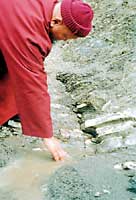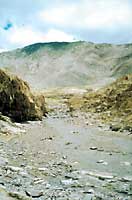|
|
||||
|
On-site survey opens new
possibilities for healthcare & farming. |
||||
|
After the preliminary water project was drawn up by Jack Stern y Cia. Ltda, in April of this year, the arrival of the team of experts from Chile - who visited Tibet in August - was awaited with great anticipation. It was only after the engineers had finished their research and on-site survey that we knew for sure that a project to bring water to Gangchen and Singma Villages was actually feasible, and more importantly that there was a font of water capable of meeting all the needs (for both potable water and irrigation) of the local population. «The scope of this project is the design and construction of a potable and irrigation water supply system, in an area of Tibet that lacks such facilities. The project will benefit the only elementary school of the area where over 200 children attend; Gangchen Village inhabited by 750 persons; Singma Village inhabited by 300 persons; the only existing clinic in the area; the recently constructed monastery and retreat centre». In fact, their study initially confirms that presently water for irrigation is only available during four months of the year and that drinking water supplies are confined to stagnant ponds during the dry months having various ill effects on the health of the entire community. «Currently the use of contaminated water and the lack of hygiene, in general, maintains the population with chronic stomach, intestinal, skin and eye diseases, and with a short life expectancy. The supply of potable water will allow for the improvement of living conditions for the inhabitants of this area. The permanent supply of irrigation water throughout the year will allow for the cultivation of vegetables and medicinal plants thus also improving the nutrition of the community. The proposed water system will ensure clean drinking water for 12 months of the year and extend the growing season by providing irrigation for 6 more months of the year». Undoubtledly, the access to clean water will bring innumerable benefits to the 1,500 inhabitants of this particularly arid region of Tibet and one of the main focuses of the project in fact concentrates on «the potential for improving the sanitary conditions and thereby the health of the people of this area» through the provision of clean water. «By supplying a year round source of clean drinking water, we will be providing the foundation upon which a future program of personal hygiene and basic health care can be based». In the West, we are used to unlimited drinking water and water companies usually estimate the use of 200 lt. per person per day in big cities. In rural areas, the amount is estimated at beween 50-80 lt. per person per day. «Considering that the inhabitants of this high altitude desert have been leading lives for centuries without access to clean water, toilets and other commodities, it is considered sufficient, in this first stage of the project, to provide 20 lt. per person per day». This means - taking into consideration the 4000 lt. a day for the elementary school, 15000 lt. a day for Gangchen Village, 6000 lt. a day for Singma Village, 3600 lt. a day for Gangchen Monastery, 2400 lt. a day for the Reteat Centre and 5000 lt. a day for the Clinic - a total of 36000 lt. of drinking water each day. «The project considers a minimum supply of 36000 lt. per day of drinking water. This translates into a supply of 0.42 lt. per second to fulfil the drinking water requirements of this project. About one quarter of the water to be supplied will be allotted for drinking, cooking and personal hygiene. The remaining 2.58 lt. per second will be available for irrigation. The system we have designed is, however, totally flexible in that all the area where drinking water is required will automatically receive the available water before the irrigation needs are met». The project considers the use of a drip system for irrigation - a very simple, cheap and easy to operate system - that ensures 90% efficiency in water use. «The results demonstrate that the water required is 3.88 mm per day or 38.880 lt. per hectare or 0.45 lt. per second per hectare. Given that this project considers the total supply of drinking and irrigation water of 3 lt. per second the agricultural surface to be irrigated in this first stage will be 6 hectares». For the villagers of Gangchen this means the possibility to grow 6 hectares of fresh vegetables and fruit - produce that has never been available before. After detailed research, the team concluded that a font of water located about 3500 mt. from Gangchen Monastery would be the most suitable source. «The presence of a vegetative shield on the basin near the water source was one of the most important parameters taken into account. Permanent vegetation is considered as the most significant factor in the area since such a protection, by absorbing the energy of rain impact, prevents the loss of water due to its runoff, increases the filtration of water into the soil, and reduces evaporation. Therefore the soil acts as a reservoir for underground water, thus providing water throughout the year at the draining point of the basin». In fact, the villagers confirmed that a small stream flows all the year round with an estimated flow of 3 lt. per second. This quanity will of course have to be rechecked during the dry winter season. The work to capture and transport the water described in the project has been designed taking special care to avoid impact on the environment, the landscape, and the natural beauty of the surroundings. The water will be captured at the 0.0. m point - at the altitude of 4153 m where the springs appear in the water shed. «A stone wall reinforced with steel ties and pillars will be built, which will be used for water retention and as a decanter, preventing suspended particles from entering the piping system. The decanted water will be conducted through 4” steel piping to a holding chamber also built with reinforced stone walls, where the water will be pre-filtered before entering the conduction piping». The drinking water will be accumulated in potable water tanks. The first tank will be built behind the monastery and will have four outlets. «The tank will measure 3 x 5 m with a depth of 2 m and will be closed with an inspection cover measuring 0.6 m x 0.6 m. The tank will be built with rock walls reinforced with steel ties and pillars. The top part of the tank will be closed with a H-20 reinforced concrete slab of 8 cm thickness. The inside of the tank will be waterproofed with a 2.5 cm thick layer of plaster. The first 3” outlet will evacuate water that will not be purified to the irrigation water tank. The second outlet will conduct water to the purifying plant that will supply the school and Singma Village. The third outlet will conduct water to the purifying plant that will serve Gangchen Village, the clinic, monastery and retreat centre. The fourth outlet will be used for washing the tank and conducting the washing water to the irrigation tank». A second, slightly smaller tank with a floating valve to prevent overflowing, will be built below the wall that surrounds the retreat centre. This tank will provide water to Singma Village and the school. To purify and disinfect the water for human consumption, two plants will be needed where mechanical filters will remove impurities from the water and Ultra Violet Light will be used to disinfect and eliminate germs, bacteria and parasites. There are many advantage to using UV light, it is environmentally friendly and eliminates the need to use chemicals, it is extremely economical and easy to operate, but probably most importantly for the people who will drink the water it destroys 99.9 % of the micro-organisms that are the main cause of sicknesses such as dysentery, diarrhea, enteric fever, typhoid fever, cholera... The necessary electrical energy needed for the UV system will be constantly supplied by a small photovoltaic system with a 210 wh capacity. From the purifying plant the water will be piped to its final destination. «Gangchen Village, 7 faucets will be installed in the patios of designated houses, where the owners will be responsible for the correct water use. Clinic, 2 faucets will be installed in the places designated by the doctor. Monastery, 3 faucets will be installed (in the kitchen, central patio and monks sleeping quarters). Retreat centre, 2 faucets of potable water will be installed. Singma Village, 3 faucets in the patios of designated houses. School, 3 faucets - one in the central patio and the other two on either side of the school building». The project finally points out that during the survey it was noticed that the water arriving under pressure at the main collection tank contained sufficient amounts of kinetic energy to generate very useful electric power. Taking this into consideration the project now includes an integrated hydroelectrical plant capable of delivering 1.5 kw twenty-four hours a day. «A small hydroelectric plant will be positioned at the entrance to the main collection tank. It will consist of a Pelton Turbine directly coupled to an A/C 220 V electric generator and will include all necessary electronic controls. From there, electric lines will be buried along with the water pipes that go to the retreat centre, monastery and clinic. A bypass valve will be installed so repairs can be carried out on the electrical system without cutting the flow of the water». This system will really bring Gangchen out of the dark ages by providing power to run approximately 50 lightbulbs, as well as a small refrigerator planned for the clinic where modern medicines requiring refrigeration can be kept on hand and who knows maybe in the future even a computer.... |
||||
|
|
||||



